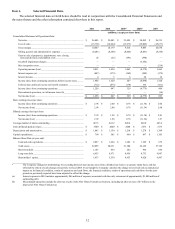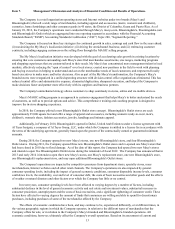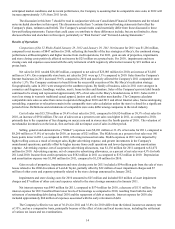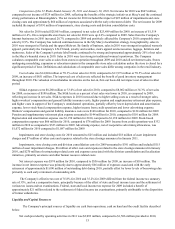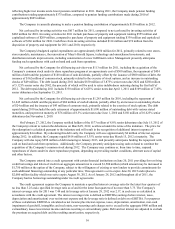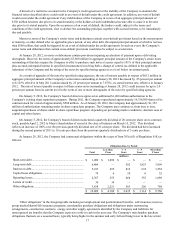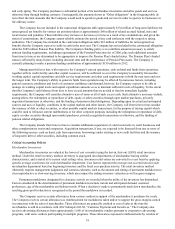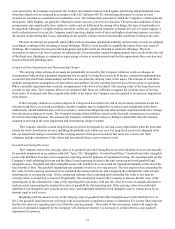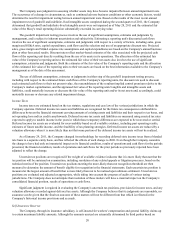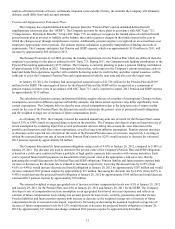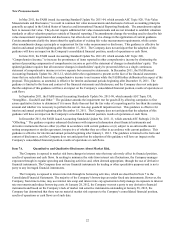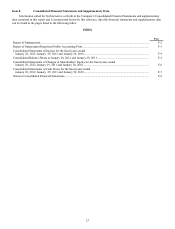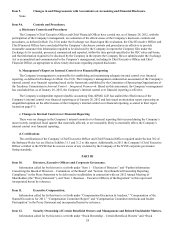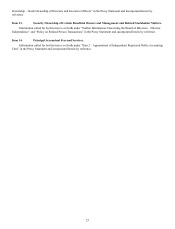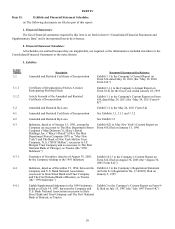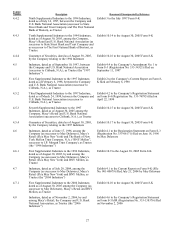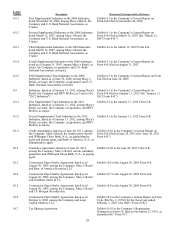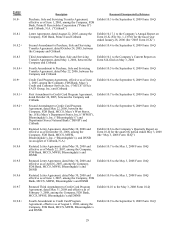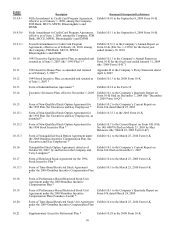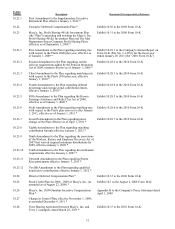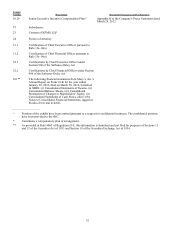Macy's 2011 Annual Report Download - page 28
Download and view the complete annual report
Please find page 28 of the 2011 Macy's annual report below. You can navigate through the pages in the report by either clicking on the pages listed below, or by using the keyword search tool below to find specific information within the annual report.22
New Pronouncements
In May 2011, the FASB issued Accounting Standard Update No. 2011-04, which amends ASC Topic 820, “Fair Value
Measurements and Disclosures,” to result in common fair value measurements and disclosures between accounting principles
generally accepted in the United States of America and International Financial Reporting Standards. The amendments explain
how to measure fair value. They do not require additional fair value measurements and are not intended to establish valuation
standards or affect valuation practices outside of financial reporting. The amendments change the wording used to describe fair
value measurement requirements and disclosures, but often do not result in a change in the application of current guidance.
Certain amendments clarify the intent about the application of existing fair value measurement requirements, while certain
other amendments change a principle or requirement for fair value measurement or disclosure. This guidance is effective for
interim and annual periods beginning after December 15, 2011. The Company does not anticipate that the adoption of this
guidance will have an impact on the Company's consolidated financial position, results of operations or cash flows.
In June 2011, the FASB issued Accounting Standard Update No. 2011-05, which amends ASC Topic 220,
“Comprehensive Income,” to increase the prominence of items reported in other comprehensive income by eliminating the
option of presenting components of comprehensive income as part of the statement of changes in shareholders' equity. The
updated guidance requires that all nonowner changes in shareholders' equity be presented either as a single continuous
statement of comprehensive income or in two separate but consecutive statements. In December 2011, the FASB issued
Accounting Standards Update No. 2011-12, which defers the requirement to present on the face of the financial statements
items that are reclassified from other comprehensive income to net income while the FASB further deliberates this aspect of the
proposal. This guidance, as amended, is effective for interim and annual periods beginning after December 15, 2011. The
guidance is limited to the form and content of the financial statements and disclosures, and the Company does not anticipate
that the adoption of this guidance will have an impact on the Company's consolidated financial position, results of operations or
cash flows.
In September 2011, the FASB issued Accounting Standards Update No. 2011-08, which amends ASC Topic 350,
“Intangibles - Goodwill and Other.” The guidance amends the impairment test for goodwill by allowing companies to first
assess qualitative factors to determine if it is more likely than not that the fair value of a reporting unit is less than the carrying
amount and whether it is necessary to perform the current two-step goodwill impairment test. This guidance is effective for
interim and annual periods beginning after December 15, 2011. The Company does not anticipate that the adoption of this
guidance will have an impact on the Company's consolidated financial position, results of operations or cash flows.
In December 2011, the FASB issued Accounting Standards Update No. 2011-11, which amends ASC Subtopic 210-20,
“Offsetting.” The guidance requires enhanced disclosures with improved information about financial instruments and
derivative instruments that are either (i) offset in accordance with current guidance or (ii) subject to an enforceable master
netting arrangement or similar agreement, irrespective of whether they are offset in accordance with current guidance. This
guidance is effective for interim and annual periods beginning after January 1, 2013. The guidance is limited to the form and
content of disclosures, and the Company does not anticipate that the adoption of this guidance will have an impact on the
Company's consolidated financial position, results of operations or cash flows.
Item 7A. Quantitative and Qualitative Disclosures About Market Risk.
The Company is exposed to market risk from changes in interest rates that may adversely affect its financial position,
results of operations and cash flows. In seeking to minimize the risks from interest rate fluctuations, the Company manages
exposures through its regular operating and financing activities and, when deemed appropriate, through the use of derivative
financial instruments. The Company does not use financial instruments for trading or other speculative purposes and is not a
party to any leveraged financial instruments.
The Company is exposed to interest rate risk through its borrowing activities, which are described in Note 7 to the
Consolidated Financial Statements. The majority of the Company’s borrowings are under fixed rate instruments. However, the
Company, from time to time, may use interest rate swap and interest rate cap agreements to help manage its exposure to interest
rate movements and reduce borrowing costs. At January 28, 2012, the Company was not a party to any derivative financial
instruments and based on the Company’s lack of market risk sensitive instruments outstanding at January 28, 2012, the
Company has determined that there was no material market risk exposure to the Company’s consolidated financial position,
results of operations or cash flows as of such date.


